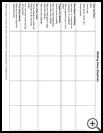
Bed-Wetting Alarms
What is a bed-wetting alarm?
Almost all children and teens who wet the bed need to get up during the night to urinate. A bed-wetting (enuresis) alarm, which is activated by moisture, can help your child learn to awaken in time to go to the bathroom. The new models are lightweight and easy for the child to operate. Enuresis alarms can be used on any child age 5 and up who wants to try one. On the other hand, they should never be imposed on a child at any age, even a teenager, if they don't want to use one.
What instructions should I give my child?
When you buy and alarm, give your child the following instructions:
- This is your alarm. It can help you cure your bed-wetting if you use it correctly. Remember that the main purpose of the alarm is to help you get up during the night and use the toilet. The alarm won't work unless you listen for it carefully and get up as soon as you hear it. Better yet, get up before the alarm goes off.
- Hook up the alarm system by yourself. Trigger the buzzer a few times by touching the moisture sensor with a wet finger and practice going to the bathroom as you will do if it goes off during the night.
- Have a night-light or flashlight near your bed so it will be easy to see what you are doing when the alarm sounds. Turn on the night-light when you go to bed.
- Give yourself a pep talk at bedtime. Remind yourself that you want to try to "beat the buzzer." You want to wake up when your bladder feels full but before any urine leaks out. If the buzzer does go off, you are going to try to wake up and stop urinating as soon as you think you hear the alarm, even if you think you are hearing it in a dream.
- As soon as you hear the alarm when you are sleeping, wake yourself up and close the valve to your bladder to stop urinating. Then jump out of bed and run to the bathroom.
- In the bathroom empty your bladder to see how much urine you were able to hold back. Then work on turning off the buzzer by removing the sensor from the wet underwear.
- Put on dry underwear and pajamas and reconnect the alarm. Put a dry towel over the wet spot on your bed. Remind yourself to get up before the alarm buzzes next time.
- In the morning, write on your calendar for that day DRY (no alarm), WET SPOT (you got up after the alarm went off), or WET (you didn't get up).
- Use the alarm every night until you go 3 or 4 weeks without wetting the bed. It usually takes 2 to 3 months before you can go 3 or 4 weeks without wetting, so keep working at it.
How can my child learn to wake up before wetting?
While your child is using the alarm, it's very important that he also practice the following self-awakening program at bedtime. Your child is trying to teach himself to awaken during the night and use the toilet when the bladder feels full. Until he learns how to do this, he won't stay dry.
Have your child practice waking up. Tell your child to:
- Lie on your bed with your eyes closed.
- Pretend it's the middle of the night.
- Pretend your bladder is full.
- Pretend you feel the pressure.
- Pretend your bladder is trying to wake you up.
- Pretend it's saying: "Get up before it's too late."
- Run to the bathroom and empty your bladder.
- Remind yourself to get up like this during the night.
What can I do to help my child?
If your child doesn't awaken immediately to the sound of the buzzer, he needs your help. You may need to help your child every night for the first 2 to 3 weeks.
- When you hear the alarm, go to your child's room as quickly as you can. Turn on the light and say loudly, "Get out of bed and stand up."
- If that doesn't work, help your child sit up. Wipe his face with a cold washcloth to bring him out of his deep sleep.
- Only after your child is standing, remind him to turn off the alarm. By all means, do not turn off the buzzer for him. Your child has to learn to carry out this step for himself.
- Make sure your child is wide awake and walks into the bathroom before you leave him. If necessary, ask him questions to help awaken him.
- Your goal is to help your child awaken immediately and get out of bed when the buzzer sounds. Stop helping him as soon as he appears to be able to wake up and get up without your help. Going to bed with the radio off, going to bed at a reasonable hour, and using a night-light can help your child respond faster to the alarm.
Where can I get a bed-wetting alarm?
- Your local pharmacy
- Various websites such as https://bedwettingstore.com/
An alarm may be covered by health insurance if your physician writes an order for it.
Last modified: 2017-10-26
Last reviewed: 2017-06-05

